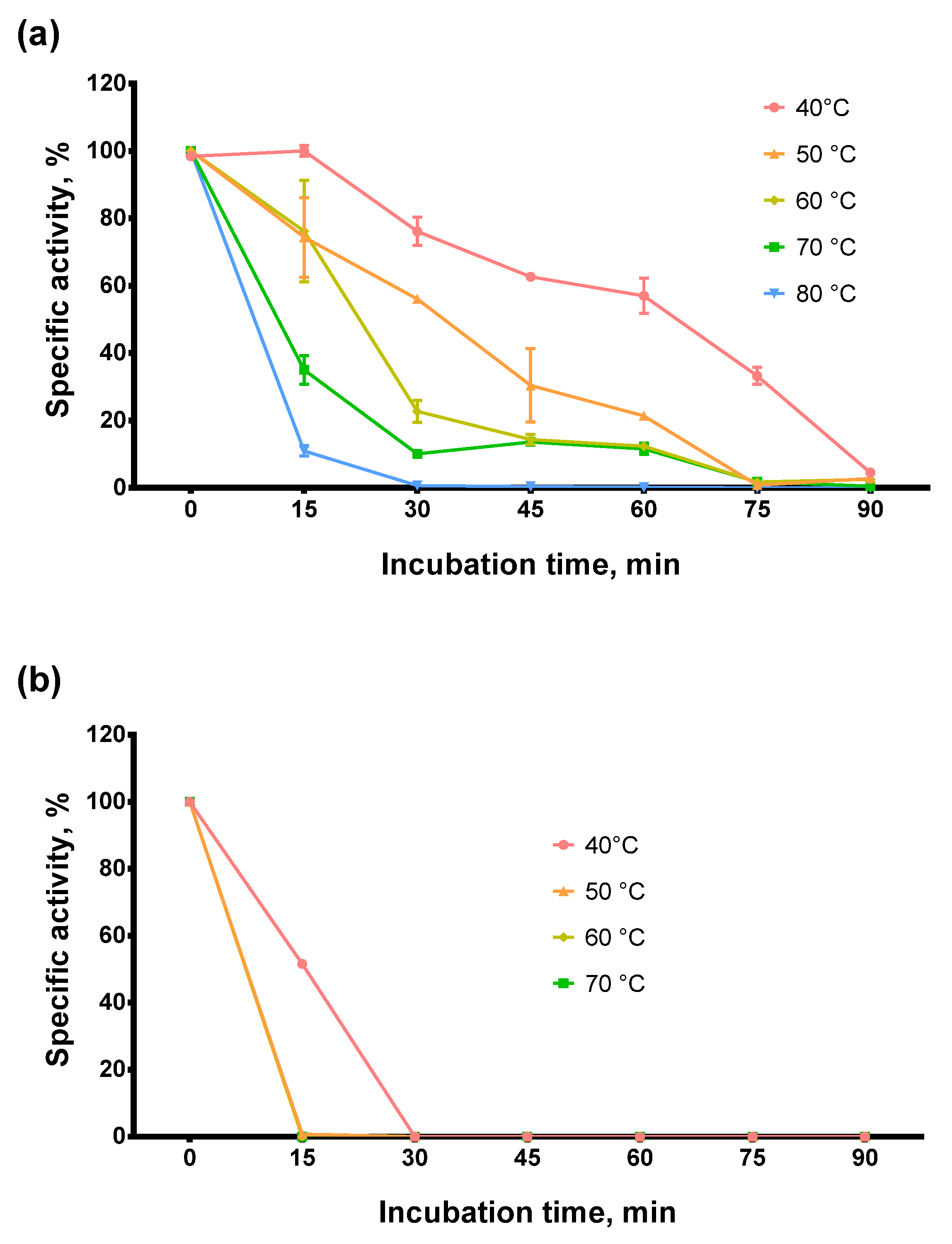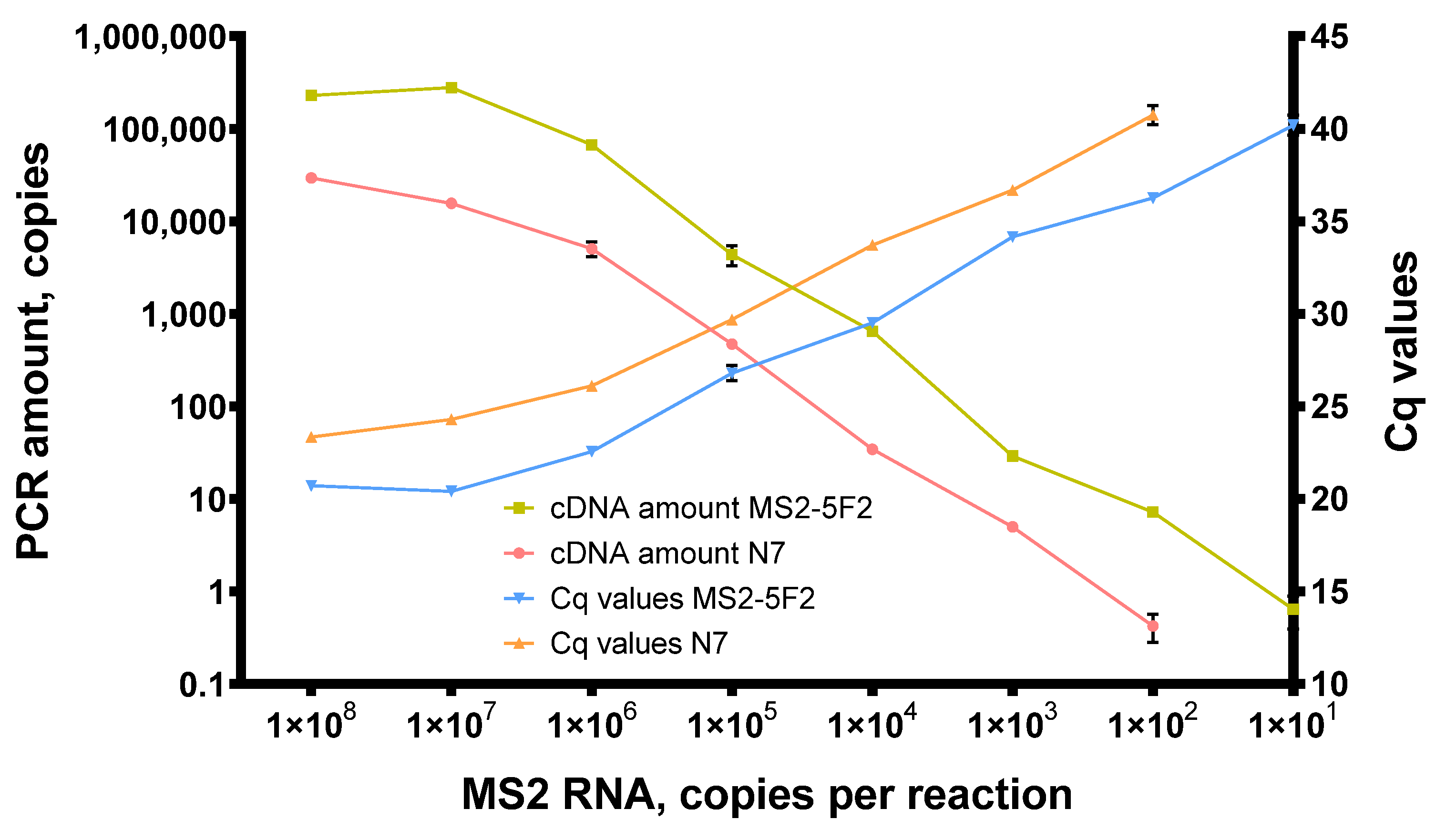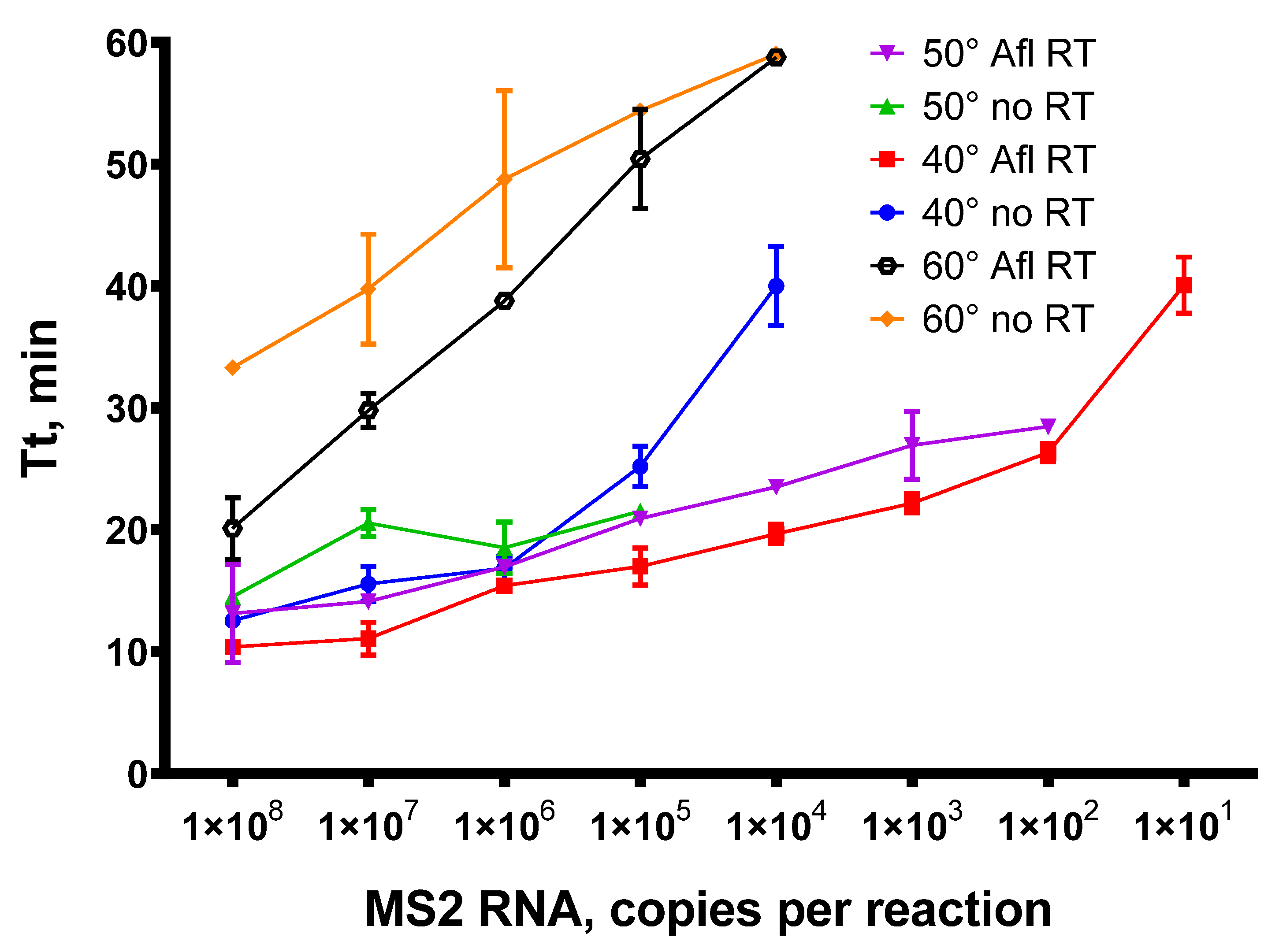A Novel Thermostable and Processive Reverse Transcriptase from a Group II Intron of Anoxybacillus flavithermus
Abstract
1. Introduction
2. Materials and Methods
2.1. Search and Selection of Afl RT Coding Sequence
2.2. Expression and Purification of Afl RT
2.3. Reverse Transcriptase Activity Assay
2.4. Thermal Stability, Optimal Temperature, and Ion Concentration
2.5. cDNA Synthesis
2.6. Quantitative PCR
2.7. Reverse-Transcription Quantitative Loop-Mediated Isothermal Amplification (RT-qLAMP)
2.8. Processivity Assay
2.9. Droplet Digital PCR
3. Results
3.1. Search for the Afl RT Gene and Purification of Afl RT
3.2. Biochemical Properties of Afl RT
3.2.1. Optimal Temperature and Thermostability
3.2.2. Optimal Reaction Buffer
3.3. Afl RT in Practical Applications
3.3.1. Afl RT in Reverse Transcription
3.3.2. Afl RT in RT-qLAMP
3.3.3. Processivity of Afl RT
4. Discussion
5. Conclusions
Supplementary Materials
Author Contributions
Funding
Institutional Review Board Statement
Informed Consent Statement
Data Availability Statement
Conflicts of Interest
References
- Michel, F.; Ferat, J.-L. Structure and Activities of Group II Introns. Annu. Rev. Biochem. 1995, 64, 435–461. [Google Scholar] [CrossRef] [PubMed]
- Lampson, B.C.; Inouye, M.; Inouye, S. Reverse Transcriptase with Concomitant Ribonuclease H Activity in the Cell-Free Synthesis of Branched RNA-Linked MsDNA of Myxococcus Xanthus. Cell 1989, 56, 701–707. [Google Scholar] [CrossRef] [PubMed]
- Liu, M.; Deora, R.; Doulatov, S.R.; Gingery, M.; Eiserling, F.A.; Preston, A.; Maskell, D.J.; Simons, R.W.; Cotter, P.A.; Parkhill, J.; et al. Reverse Transcriptase-Mediated Tropism Switching in Bordetella Bacteriophage. Science (80-) 2002, 295, 2091–2094. [Google Scholar] [CrossRef] [PubMed]
- Fortier, L.-C.; Bouchard, J.D.; Moineau, S. Expression and Site-Directed Mutagenesis of the Lactococcal Abortive Phage Infection Protein AbiK. J. Bacteriol. 2005, 187, 3721–3730. [Google Scholar] [CrossRef] [PubMed]
- Wang, C.; Villion, M.; Semper, C.; Coros, C.; Moineau, S.; Zimmerly, S. A Reverse Transcriptase-Related Protein Mediates Phage Resistance and Polymerizes Untemplated DNA in Vitro. Nucleic Acids Res. 2011, 39, 7620–7629. [Google Scholar] [CrossRef] [PubMed]
- Silas, S.; Mohr, G.; Sidote, D.J.; Markham, L.M.; Sanchez-Amat, A.; Bhaya, D.; Lambowitz, A.M.; Fire, A.Z. Direct CRISPR Spacer Acquisition from RNA by a Natural Reverse Transcriptase-Cas1 Fusion Protein. Science 2016, 351, aad4234. [Google Scholar] [CrossRef] [PubMed]
- Millman, A.; Bernheim, A.; Stokar-Avihail, A.; Fedorenko, T.; Voichek, M.; Leavitt, A.; Oppenheimer-Shaanan, Y.; Sorek, R. Bacterial Retrons Function In Anti-Phage Defense. Cell 2020, 183, 1551–1561.e12. [Google Scholar] [CrossRef] [PubMed]
- Mestre, M.R.; Gao, L.A.; Shah, S.A.; López-Beltrán, A.; González-Delgado, A.; Martínez-Abarca, F.; Iranzo, J.; Redrejo-Rodríguez, M.; Zhang, F.; Toro, N. UG/Abi: A Highly Diverse Family of Prokaryotic Reverse Transcriptases Associated with Defense Functions. Nucleic Acids Res. 2022, 50, 6084–6101. [Google Scholar] [CrossRef]
- Guo, H.; Arambula, D.; Ghosh, P.; Miller, J.F. Diversity-Generating Retroelements in Phage and Bacterial Genomes. Microbiol. Spectr. 2014, 2. [Google Scholar] [CrossRef]
- Lambowitz, A.M.; Belfort, M. Mobile Bacterial Group II Introns at the Crux of Eukaryotic Evolution. Microbiol. Spectr. 2015, 3, MDNA3-0050-2014. [Google Scholar] [CrossRef]
- Lambowitz, A.M.; Zimmerly, S. Group II Introns: Mobile Ribozymes That Invade DNA. Cold Spring Harb. Perspect. Biol. 2011, 3, a003616. [Google Scholar] [CrossRef] [PubMed]
- Park, S.K.; Mohr, G.; Yao, J.; Russell, R.; Lambowitz, A.M. Group II Intron-like Reverse Transcriptases Function in Double-Strand Break Repair. Cell 2022, 185, 3671–3688.e23. [Google Scholar] [CrossRef] [PubMed]
- Chandramouly, G.; Zhao, J.; McDevitt, S.; Rusanov, T.; Hoang, T.; Borisonnik, N.; Treddinick, T.; Lopezcolorado, F.W.; Kent, T.; Siddique, L.A.; et al. Polθ Reverse Transcribes RNA and Promotes RNA-Templated DNA Repair. Sci. Adv. 2021, 7, eabf1771. [Google Scholar] [CrossRef] [PubMed]
- Mohr, S.; Ghanem, E.; Smith, W.; Sheeter, D.; Qin, Y.; King, O.; Polioudakis, D.; Iyer, V.R.; Hunicke-Smith, S.; Swamy, S.; et al. Thermostable Group II Intron Reverse Transcriptase Fusion Proteins and Their Use in CDNA Synthesis and Next-Generation RNA Sequencing. RNA 2013, 19, 958–970. [Google Scholar] [CrossRef] [PubMed]
- Zhao, C.; Liu, F.; Pyle, A.M. An Ultraprocessive, Accurate Reverse Transcriptase Encoded by a Metazoan Group II Intron. RNA 2018, 24, 183–195. [Google Scholar] [CrossRef] [PubMed]
- Vellore, J.; Moretz, S.E.; Lampson, B.C. A Group II Intron-Type Open Reading Frame from the Thermophile Bacillus (Geobacillus) Stearothermophilus Encodes a Heat-Stable Reverse Transcriptase. Appl. Environ. Microbiol. 2004, 70, 7140–7147. [Google Scholar] [CrossRef] [PubMed]
- Toor, N.; Keating, K.S.; Taylor, S.D.; Pyle, A.M. Crystal Structure of a Self-Spliced Group II Intron. Science 2008, 320, 77–82. [Google Scholar] [CrossRef] [PubMed]
- Matsuura, M.; Saldanha, R.; Ma, H.; Wank, H.; Yang, J.; Mohr, G.; Cavanagh, S.; Dunny, G.M.; Belfort, M.; Lambowitz, A.M. A Bacterial Group II Intron Encoding Reverse Transcriptase, Maturase, and DNA Endonuclease Activities: Biochemical Demonstration of Maturase Activity and Insertion of New Genetic Information within the Intron. Genes Dev. 1997, 11, 2910–2924. [Google Scholar] [CrossRef]
- Muñoz-Adelantado, E.; San Filippo, J.; Martínez-Abarca, F.; García-Rodríguez, F.M.; Lambowitz, A.M.; Toro, N. Mobility of the Sinorhizobium meliloti Group II Intron RmInt1 Occurs by Reverse Splicing into DNA, but Requires an Unknown Reverse Transcriptase Priming Mechanism. J. Mol. Biol. 2003, 327, 931–943. [Google Scholar] [CrossRef]
- Smathers, C.M.; Robart, A.R. Transitions between the Steps of Forward and Reverse Splicing of Group IIC Introns. RNA 2020, 26, 664–673. [Google Scholar] [CrossRef]
- Robart, A.R.; Seo, W.; Zimmerly, S. Insertion of Group II Intron Retroelements after Intrinsic Transcriptional Terminators. Proc. Natl. Acad. Sci. USA 2007, 104, 6620–6625. [Google Scholar] [CrossRef] [PubMed]
- Sharifi, F.; Ye, Y. Identification and Classification of Reverse Transcriptases in Bacterial Genomes and Metagenomes. Nucleic Acids Res. 2022, 50, e29. [Google Scholar] [CrossRef] [PubMed]
- Oscorbin, I.P.; Boyarskikh, U.A.; Filipenko, M.L. Large Fragment of DNA Polymerase I from Geobacillus sp. 777: Cloning and Comparison with DNA Polymerases I in Practical Applications. Mol. Biotechnol. 2015, 57, 947–959. [Google Scholar] [CrossRef] [PubMed]
- Heinen, W.; Lauwers, A.M.; Mulders, J.W. Bacillus Flavothermus, a Newly Isolated Facultative Thermophile. Antonie Van Leeuwenhoek 1982, 48, 265–272. [Google Scholar] [CrossRef] [PubMed]
- Bakir, Z.B.; Metin, K. Purification and Characterization of an Alkali-Thermostable Lipase from Thermophilic Anoxybacillus flavithermus HBB 134. J. Microbiol. Biotechnol. 2016, 26, 1087–1097. [Google Scholar] [CrossRef] [PubMed]
- Özdemir, S.; Matpan, F.; Okumus, V.; Dündar, A.; Ulutas, M.S.; Kumru, M. Isolation of a Thermophilic Anoxybacillus flavithermus sp. Nov. and Production of Thermostable α-Amylase under Solid-State Fermentation (SSF). Ann. Microbiol. 2012, 62, 1367–1375. [Google Scholar] [CrossRef]
- Aliakbari, N.; Mirzaee, Z.; Jafarian, V.; Khalifeh, K.; Salehi, M. Genetic and Biochemical Characterization of a Novel Thermostable Cyclomaltodextrinase From Anoxybacillus flavithermus. Starch—Stärke 2019, 71, 1800133. [Google Scholar] [CrossRef]
- Ellis, J.T.; Magnuson, T.S. Thermostable and Alkalistable Xylanases Produced by the Thermophilic Bacterium Anoxybacillus flavithermus TWXYL3. ISRN Microbiol. 2012, 2012, 517524. [Google Scholar] [CrossRef]
- Yasukawa, K.; Nemoto, D.; Inouye, K. Comparison of the Thermal Stabilities of Reverse Transcriptases from Avian Myeloblastosis Virus and Moloney Murine Leukaemia Virus. J. Biochem. 2008, 143, 261–268. [Google Scholar] [CrossRef]
- Gerard, G.F.; Potter, R.J.; Smith, M.D.; Rosenthal, K.; Dhariwal, G.; Lee, J.; Chatterjee, D.K. The Role of Template-Primer in Protection of Reverse Transcriptase from Thermal Inactivation. Nucleic Acids Res. 2002, 30, 3118–3129. [Google Scholar] [CrossRef]
- Kristen, M.; Plehn, J.; Marchand, V.; Friedland, K.; Motorin, Y.; Helm, M.; Werner, S. Manganese Ions Individually Alter the Reverse Transcription Signature of Modified Ribonucleosides. Genes 2020, 11, 950. [Google Scholar] [CrossRef] [PubMed]
- Valverde-Garduño, V.; Gariglio, P.; Gutiérrez, L. Functional Analysis of HIV-1 Reverse Transcriptase Motif C: Site-Directed Mutagenesis and Metal Cation Interaction. J. Mol. Evol. 1998, 47, 73–80. [Google Scholar] [CrossRef] [PubMed]
- Sirover, M.A.; Loeb, L.A. On the Fidelity of DNA Replication. Effect of Metal Activators during Synthesis with Avian Myeloblastosis Virus DNA Polymerase. J. Biol. Chem. 1977, 252, 3605–3610. [Google Scholar] [CrossRef] [PubMed]
- Malboeuf, C.M.; Isaacs, S.J.; Tran, N.H.; Kim, B. Thermal Effects on Reverse Transcription: Improvement of Accuracy and Processivity in CDNA Synthesis. Biotechniques 2001, 30, 1074–1084. [Google Scholar] [CrossRef] [PubMed]
- Konishi, A.; Yasukawa, K.; Inouye, K. Improving the Thermal Stability of Avian Myeloblastosis Virus Reverse Transcriptase α-Subunit by Site-Directed Mutagenesis. Biotechnol. Lett. 2012, 34, 1209–1215. [Google Scholar] [CrossRef] [PubMed]
- Álvarez, M.; Matamoros, T.; Menéndez-Arias, L. Increased Thermostability and Fidelity of DNA Synthesis of Wild-Type and Mutant HIV-1 Group O Reverse Transcriptases. J. Mol. Biol. 2009, 392, 872–884. [Google Scholar] [CrossRef] [PubMed][Green Version]
- DeStefano, J.J.; Buiser, R.G.; Mallaber, L.M.; Myers, T.W.; Bambara, R.A.; Fay, P.J. Polymerization and RNase H Activities of the Reverse Transcriptases from Avian Myeloblastosis, Human Immunodeficiency, and Moloney Murine Leukemia Viruses Are Functionally Uncoupled. J. Biol. Chem. 1991, 266, 7423–7431. [Google Scholar] [CrossRef]
- Potapov, V.; Fu, X.; Dai, N.; Corrêa, I.R.; Tanner, N.A.; Ong, J.L. Base Modifications Affecting RNA Polymerase and Reverse Transcriptase Fidelity. Nucleic Acids Res. 2018, 46, 5753–5763. [Google Scholar] [CrossRef]
- Ng, B.; Nayak, S.; Gibbs, M.D.; Lee, J.; Bergquist, P.L. Reverse Transcriptases: Intron-Encoded Proteins Found in Thermophilic Bacteria. Gene 2007, 393, 137–144. [Google Scholar] [CrossRef]
- Haack, D.B.; Yan, X.; Zhang, C.; Hingey, J.; Lyumkis, D.; Baker, T.S.; Toor, N. Cryo-EM Structures of a Group II Intron Reverse Splicing into DNA. Cell 2019, 178, 612–623.e12. [Google Scholar] [CrossRef]
- Roth, M.J.; Tanese, N.; Goff, S.P. Purification and Characterization of Murine Retroviral Reverse Transcriptase Expressed in Escherichia coli. J. Biol. Chem. 1985, 260, 9326–9335. [Google Scholar] [CrossRef] [PubMed]
- Vashishtha, A.K.; Konigsberg, W.H. The Effect of Different Divalent Cations on the Kinetics and Fidelity of Bacillus Stearothermophilus DNA Polymerase. AIMS Biophys. 2018, 5, 125–143. [Google Scholar] [CrossRef] [PubMed]
- Evans, G.A. Molecular Cloning: A Laboratory Manual. Second Edition. Volumes 1, 2, and 3. Current Protocols in Molecular Biology. Volumes 1 and 2; Cold Spring Harbor Laboratory Press: New York, NY, USA, 1990. [Google Scholar] [CrossRef]









| Name | 5′-Sequence-3′ |
|---|---|
| MS2-FAM | FAM-GCCATTTTTAATGTCTTTAGCGAG |
| MS2-2-F3 | TGCCTGTAAGGAGCCTGAT |
| MS2-2-B3 | TGAGCGGATACGATCGAGAT |
| MS2-2-LB | GTCTATACCAACGGATTTGAGCC |
| MS2-2-LF | GCATCCGATTCCATCTCCGAT |
| MS2-2-FIP | GCCAGACGCTGGTTGATCGATTAAGGGGTCGGTGCTTTCA |
| MS2-2-BIP | GGTTCGCTTGCGACGATAGACTTCTGGTGGGAGAAAACTCCA |
| MS2-5-F2 | GCCATTTTTAATGTCTTTAGCGAG |
| MS2-5-R2 | AGGAATGGAATTCCGGCT |
| MS2-5-P | FAM-TCCCTCGACGCACGCTCCTGCT-BHQ1 |
| MS2-3-F | TGTGCTCGAAAGAGCACG |
| MS2-3-R | GAATCCCGGGTCCTCTCT |
| MS2-3-P | HEX-AGCGGTCCGGCTCCA-BHQ1 |
| RT | GenBank ID | Length, a.a. | MW, kDa | pI | Net Charge at pH 7.0 |
|---|---|---|---|---|---|
| M-MuLV RT | NP_955591.1 | 671 | 74.6 | 8.67 | 7.73 |
| HIV-1 RT | 1LWF_A | 560 | 64.5 | 8.69 | 5.53 |
| TeI-4c RT | BAC08074.1 | 564 | 64.7 | 10.03 | 45.3 |
| Gs1-2c | AAT72329.1 | 420 | 48.6 | 10.59 | 36.21 |
| Afl RT | WP_012575961.1 | 418 | 49.7 | 10.66 | 42.41 |
Disclaimer/Publisher’s Note: The statements, opinions and data contained in all publications are solely those of the individual author(s) and contributor(s) and not of MDPI and/or the editor(s). MDPI and/or the editor(s) disclaim responsibility for any injury to people or property resulting from any ideas, methods, instructions or products referred to in the content. |
© 2023 by the authors. Licensee MDPI, Basel, Switzerland. This article is an open access article distributed under the terms and conditions of the Creative Commons Attribution (CC BY) license (https://creativecommons.org/licenses/by/4.0/).
Share and Cite
Oscorbin, I.P.; Filipenko, M.L. A Novel Thermostable and Processive Reverse Transcriptase from a Group II Intron of Anoxybacillus flavithermus. Biomolecules 2024, 14, 49. https://doi.org/10.3390/biom14010049
Oscorbin IP, Filipenko ML. A Novel Thermostable and Processive Reverse Transcriptase from a Group II Intron of Anoxybacillus flavithermus. Biomolecules. 2024; 14(1):49. https://doi.org/10.3390/biom14010049
Chicago/Turabian StyleOscorbin, Igor P., and Maxim L. Filipenko. 2024. "A Novel Thermostable and Processive Reverse Transcriptase from a Group II Intron of Anoxybacillus flavithermus" Biomolecules 14, no. 1: 49. https://doi.org/10.3390/biom14010049
APA StyleOscorbin, I. P., & Filipenko, M. L. (2024). A Novel Thermostable and Processive Reverse Transcriptase from a Group II Intron of Anoxybacillus flavithermus. Biomolecules, 14(1), 49. https://doi.org/10.3390/biom14010049







